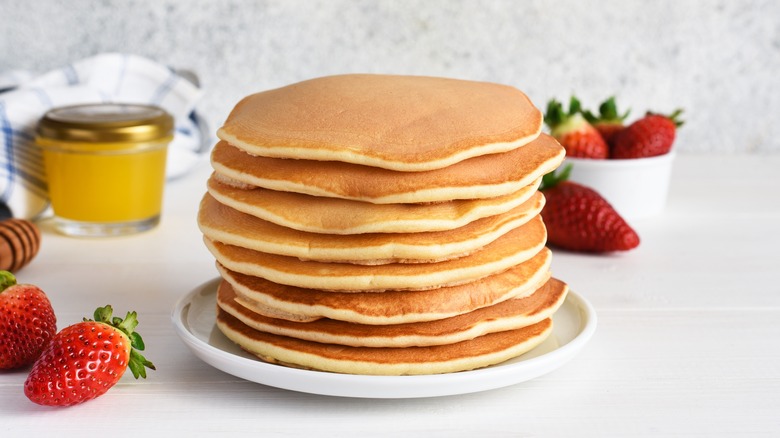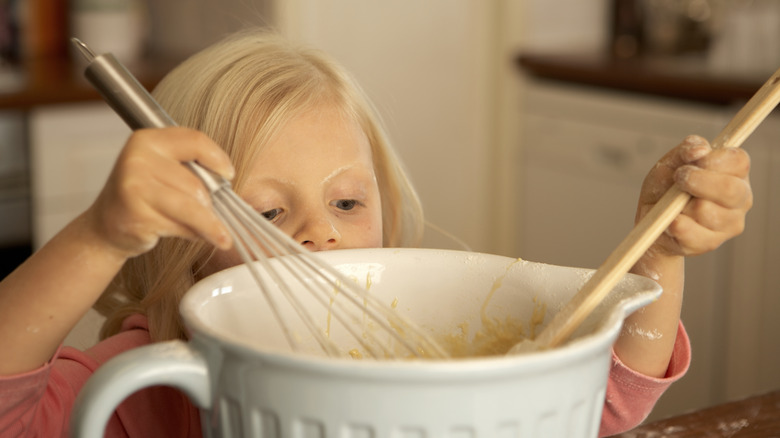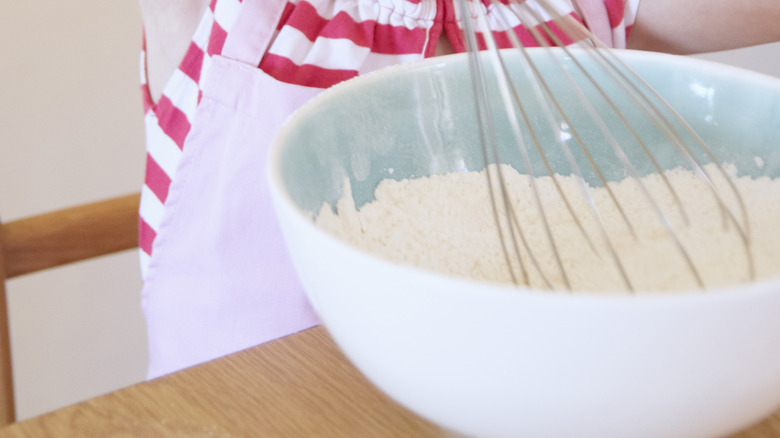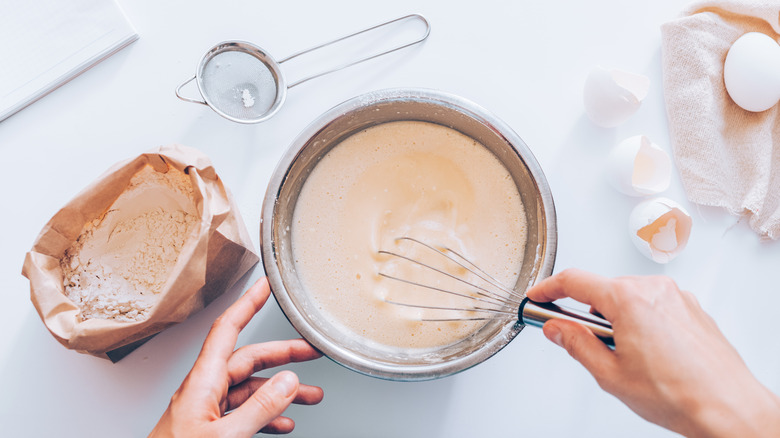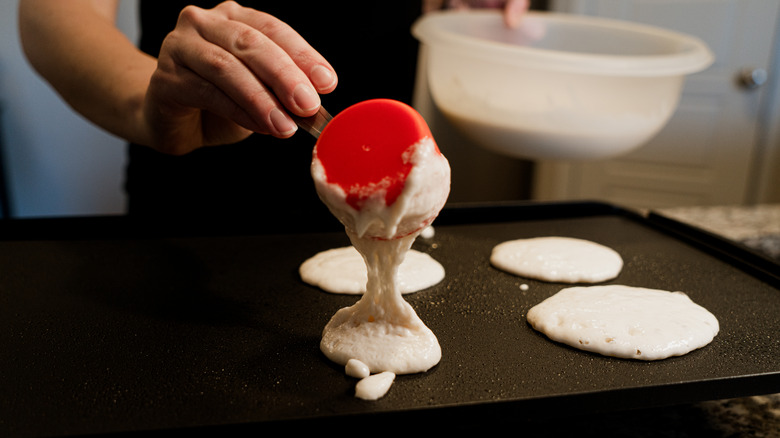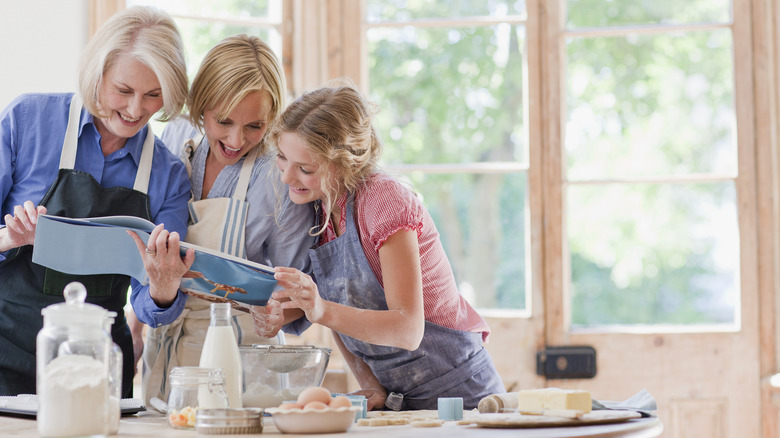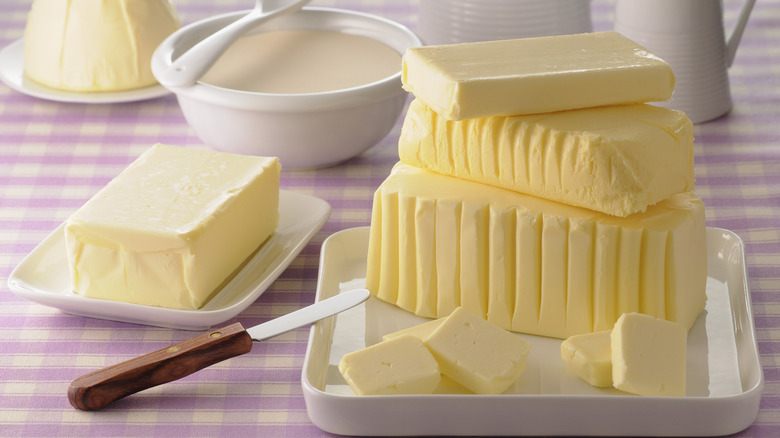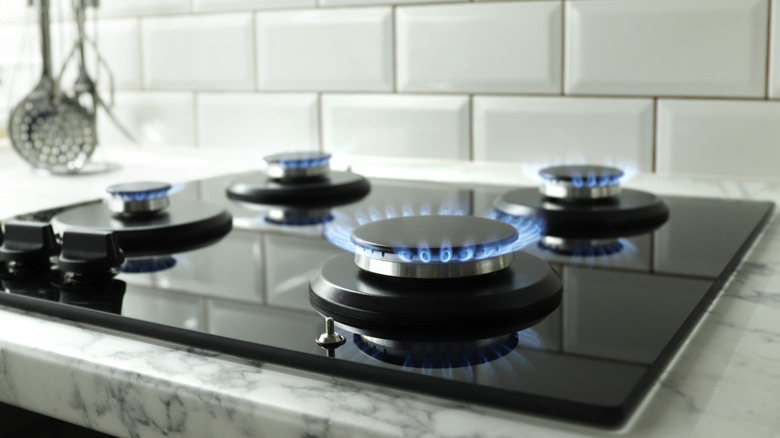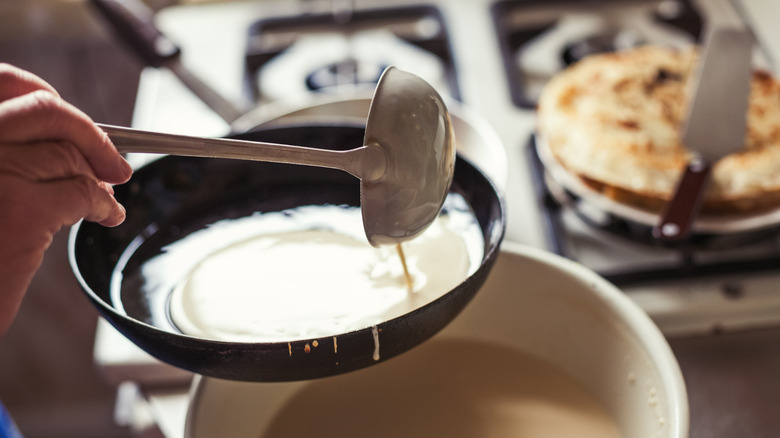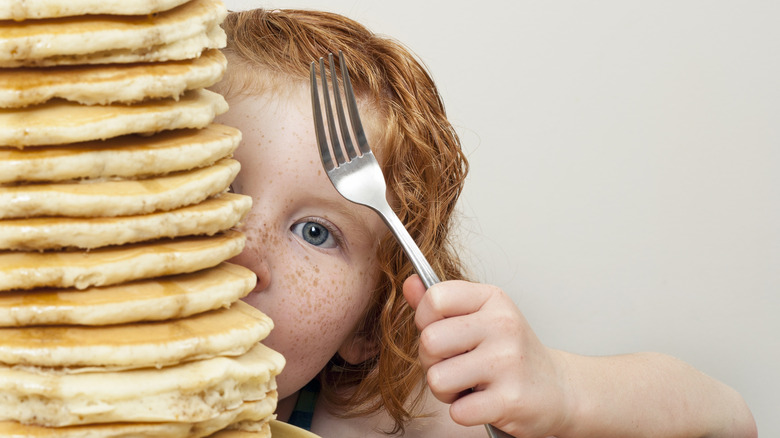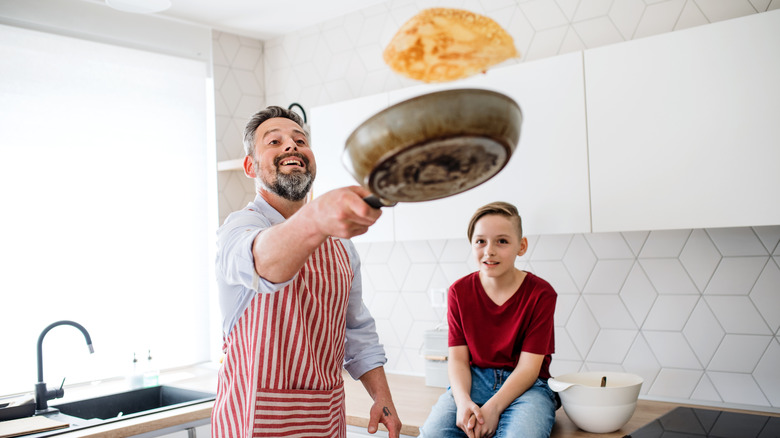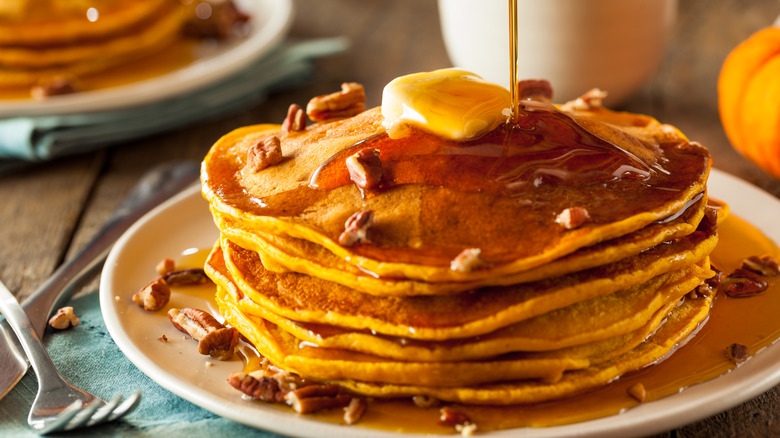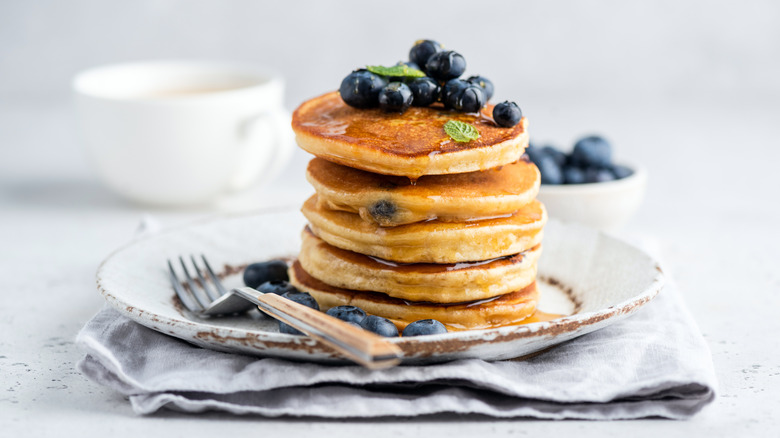12 Ways You Are Ruining Pancakes
Who doesn't love saddling up to the breakfast table, and finding a heaping stack of pancakes waiting to be devoured? The glistening of syrup running down the tower of baked goods was like tears of happiness. You know it's going to be a good day because it's already starting off right.
That is unless the pancakes are absolutely butchered. You'd think pancakes should be easy enough to make, right? Only a few ingredients, fry it up, then devour. But therein lies the problem. There are minimal ingredients, which means a single error can greatly affect the entire quality of your breakfast.
If you're struggling with preparing perfectly tender, with just a hint of crispy-edged pancakes, chances are there is a small mistake taking place at some point during your preparation and frying process. But don't worry, you can put that box of backup breakfast cereal away. Here are many of the most common mistakes you might be making when cooking pancakes, and how you can go about correcting them.
You are mixing dry ingredients first
Maybe you saw someone on TikTok tossing wet ingredients into a bowl of dry ingredients. Or perhaps you are going off a recipe that simply says to toss all the ingredients together at once. Well, what these recipes and social media personalities aren't telling you is that the order in which you mix them is especially important. And if you're mixing dry ingredients first, you may already be ruining your breakfast before barely getting started.
So what exactly is going on? When you mix all the dry ingredients first, then add in the wet, the flour is going to end up sticking to the mixing bowl, you'll have to work extra hard to dissolve everything, and there's a chance the fat from the dry ingredients won't fully blend in the water, which can lead to clumping and other problems, none of which you don't want with your pancakes.
In fact, this might cause a domino effect, leading to the second problem on our list (more on that in a second). Instead, start with your liquids mixed first. From here you can control the pour of flour and dry ingredients, allowing you to gently whisk everything together while ensuring everything is perfectly mixed without any clumping (or sticking to the mixing bowl).
Over mixing the pancake batter
Your pancakes look great. You're dolloping your favorite Vermont maple syrup over top. It smells perfect. Taking a mouthful you begin to chew, and that's when you notice a problem.
The pancake is chewy. It's not light and airy and fluffy like the breakfast diner down the street. But why? Why is that happening? You followed the recipe correctly. You cooked it the right amount of time, and you even made sure to mix dry ingredients into wet ingredients. So what gives?
You over-mixed the batter. If you over-mix, the gluten will begin to develop within the flour. Once this happens the fried cake will respond to the developed gluten, resulting in harder, chewier pancakes. There are a few reasons why you might have over-mixed the batter. First, you're using an electric mixer. That's really not necessary. It doesn't take much to whisk everything together. Even if you are using good old-fashioned wrist strength and a whisk, it's possible you tried to obtain a completely smooth batter by working out the little chunks.
We're here to tell you the little chunks are perfectly fine. This can help with the overall texture. Don't keep mixing and mixing and mixing the batter until all these smaller globs have been taken care of. Because by doing so you're only causing an inferior product later down the line. If you are a stickler for little globs, simply pour the dry ingredients more slowly into the wet ingredients.
Not giving your batter time to sit
Pancake batter needs to be treated delicately. It needs to be loved and cared for. It's not just a few ingredients beaten together until you toss it onto a hot stove. If you want to churn out the best-tasting pancakes ever you need to show it some love, and it will show you that love in return.
This means you need to let your batter sit after it's been mixed. Let the ingredients get to know each other in the bowl. This is because there are leaveners within the mix that need time to activate. Immediately going to the griddle and pouring in the batter prevents this from happening.
You should let your batter sit for at least 30 minutes before cooking with it. However, you can let it sit for a little longer if that works for your schedule. So maybe you need to wake the kids up, or it's time to get the bacon or coffee started. Perhaps you just need to let the dog outside or grab the paper. Whatever you need to do, go do it after you're done mixing the batter. This way, when you're back inside and ready to go, your batter will be ready for the next step in expertly prepared pancakes.
Using the wrong cooking surface
So here's the thing. We love a classic cast iron skillet as much as the next person, but it isn't always the best option when it comes to cooking pancakes. Why? Because cast iron on top of a stovetop doesn't always give you an even cooking surface. Part of the cast iron might be slightly thicker than the rest of the skillet, which means the temperature will be slightly off. Or perhaps you use a gas stove that produces a ring of fire to heat. While some people swear by gas stoves (even though there's a movement to have them banned from kitchens), it doesn't offer a unified surface. An induction stove top is great for this, but realistically, the true ultimate cooking surface for pancakes is an electric griddle.
We love electric griddles for a number of reasons. First, it is going to give you an entire cooking surface that is unified. This lets you cook several pancakes at the same time. It also heats up quickly. It's also great because you can take an electric griddle with you for camping or those early morning tailgates (we personally love a delicious short stack of pancakes fresh off the griddle while camping in the woods, as there's just something different about being in the great outdoors eating pancakes, but hey, that's us).
So if you're serious about your breakfast cooking game, now is the time to invest in a quality electric griddle.
Not following the recipe exactly
We all make little tweaks and improvements to recipes. It helps us make the food our own. Maybe we're swapping out certain spices, or we remove butter and instead opt for margarine. We all do this. However, it is important to know when to stay on target with the recipe and when to go rogue. Oftentimes, the fewer ingredients there are in a recipe, the more closely you need to follow the recipe. One minor tweak and change the entire complexity of the food. This is especially the case if there is a neutralizing effect with the combination of two ingredients.
This is true with pancakes. Many pancake recipes call for buttermilk. If you don't like buttermilk you won't be the first and we know you won't be the last. There are plenty of people who love a good ranch dressing, but if they see "buttermilk" slapped on the label they'd rather toss the dressing in the trash than use it.
Here's the thing with buttermilk in pancakes, though. The acidic aspect of buttermilk reacts to the baking soda within the recipe. This is what helps deliver the amazing taste of your pancake. When you substitute buttermilk with regular milk (or any other milk alternative) you are not going to get that same reaction with the baking soda. So, if you're either using a non-buttermilk recipe, or you're substituting something for the buttermilk and your pancakes are tasting off, this might be why.
Using butter on the skillet or griddle
There are those who prefer to cook with butter, while others might prefer to cook with oil. Ideally, you'll have some flexibility with this. While you might prefer the taste of the fat that comes from butter instead of oil, there is one major problem you will run into when trying to cook pancakes with butter. The smoke point.
The smoke point for butter is far lower than that of most oils. Because you are cooking your pancakes at a higher temperature there's a greater chance of your butter burning than if you use oil. So, if you're pancakes have been burning, or there is a smoky taste to them, it is because you're using oil on your skillet, pan, or griddle. Butter may also affect the color of your pancakes, resulting in a deep brown color to it.
Instead, keep the butter for slathering on top of the pancakes and use cooking oil instead. Canola oil, for example, has a higher smoke point, and because you won't hit this smoke point while cooking the pancakes, you'll avoid the brown colors, smokey taste, and burnt bottoms. Not a fan of canola oil? It is okay, there are other kinds of fats you might want to experiment with. Clarified butter is a suitable alternative, and if you are a ghee lover, this will also work.
You are using the wrong heat to cook your pancakes
You want to set your cooking surface, whether it is the stove top, skillet, or griddle, to medium heat. This consistent temperature will give you the perfect texture and fluffiness that helps make pancakes so delicious.
Of course, every cooking surface is a bit different. This is especially the case if your oven is on the older side and the surface temperature may not be as consistent as a newer appliance. Thankfully, there are some signs that will indicate whether your cooking surface temperature is too hot or too cold.
First, if you're ending with a burned outside but a soggy, almost liquid inside, it is because the temperature is too hot. The exterior cooks far too fast and you're forced to flip sooner than necessary to avoid burning, resulting in a mushy interior. On the flip side, if the inside of the pancake is good but the outside edges of the pancake are limp and even damp, it's because the temp is too low.
Thankfully, because it's easy to whip up a large amount of batter for pancakes, there's nothing wrong with cooking a test pancake to make sure everything is good to go (and we won't tell anyone if you enjoy that fresh cake all by yourself before everyone else is up. That secret is between you, us, and maybe your dog that's eagerly waiting by your feet, hoping they can assist in your taste testing.
Adding the batter to the cooking surface too soon
With bacon, you want to start with a cold cooking surface and then allow it to heat up with the cast iron skillet. With pancakes though, you need to start off with a hot cooking surface. If you've poured your batter onto a cold cooking surface in the past, you know it is likely going to spread and ooze out of that nice circular shape you poured as it begins to break apart in the oil on the griddle.
There's nothing wrong with turning your cook surface on as you begin to work on the pancakes (or even when you step away for a few minutes to let the batter sit). You know your cooking surface better than us, so however long it takes to fully heat up, give it the time it needs.
Pouring batter onto a surface that isn't hot enough is going to result in a gooey mess, and nobody likes gooey blobs of pancake batter that have partially dissolved into the oil. So if your pancakes aren't resulting in the nice circles you'd like, it's likely because you're pouring the batter far too soon.
Cooking too many pancakes at once
Do you remember when you were a kid and you tried to help your mom or grandmother bake cookies? Maybe you put too much cookie dough into the oven, and when it came time to pull the cookies out there had all melted and smooshed together. Well, that is exactly what is going to happen with your pancakes if you're cooking too many at once. Sure the occasional conjoined pancake twins are going to happen, but as is the case with just about anything else you cook on a stovetop or griddle, cooking too many at once is going to interfere with the ability to cook properly, which in turn results in an inferior product.
This is another reason why we love using an electric griddle. You have a larger cooking space and have the ability to cook more pancakes at the same time. With a traditional stove top and cast iron skillet, you might only have enough room to cook one at a time (or maybe a few really small ones).
Overcrowding your cooking surface will prevent your pancakes from getting those all-important crispy edges, so make sure to give yourself more than enough room. And if you're cooking for a large family or a group of friends, consider investing in that electric griddle ahead of time. The money you spend to be able to cook four or six pancakes at a time instead of one is well worth it.
Flipping the pancakes too soon
Of all the problems we have run into while cooking pancakes, this is probably the most frustrating.
There's a light at the end of the tunnel. The pancake is almost done. It smells delicious and looks amazing. You slide your spatula under the pancake, and in the process of flipping the entire thing falls apart into a gooey mess. Sure, it might taste the same, but nobody wants a pancake that looks like the dog chewed it up before being served.
So what's the trick? How does anyone know when to flip pancakes, or is it just a game of luck? Thankfully, there's no luck involved with flipping pancakes. You just need to know what to look for. Watch the top of the pancake. Eventually, you will see tiny little bubbles begin to form. This means you're almost there. Once the air bubbles begin to pop it's your time to flip.
We'd recommend using a wide, flat spatula for flipping. Use the widest spatula you have on hand, as this will help reduce the weight of the unsupported part of the pancake hanging off the edge of your utensil, which in turn will help prevent any breakage of the pancake during the flip.
Not giving your pancakes enough time to cool
At the restaurant, if you watch the kitchen staff prepare your pancakes, they will stack all the cakes on top of a plate and sling it out in front of you in a matter of moments. This is perfect for melting butter and whatever other toppings you plan on adding to the pancake.
That is great if you plan on eating the pancakes immediately, but it isn't going to work all that well if you're preparing a large number of pancakes for the family or guests. If you begin stacking the pancakes immediately, the heat from the pancakes will cause the other cakes in the stack to begin sticking to one another. If they sit there for a few minutes the pancakes will then pull apart when being served up, and do you really want all your hard work to be ripped up right at the moment of glory? You want your guests to see and appreciate your beautiful work.
Instead, avoid stacking your pancakes immediately. Let the pancakes dry momentarily on a rack before serving. It only takes a few minutes for the temperature to cool down to a point they won't stick to each other. Now, if you're cooking your pancakes one at a time on a skillet you can likely skip this step as it's already taking a few minutes in between finished cakes. However, if you are using a griddle, keep a cooling rack nearby.
You haven't mastered traditional pancakes yet
Perhaps you enjoy regular pancakes, but you absolutely love specialty pancakes. You want to add chocolate chips immediately, or your grandmother always added fresh blueberries to yours, or a restaurant you once visited specialized in fried banana pancakes. All of this sounds amazing, so you decide to skip out on learning how to make traditional pancakes and instead jump right to making those specialized pancakes.
We applauded your eagerness to cook, but we also recommend you slow down a bit. Your fried banana pancake will turn out even better if you first learn how to make delicious, traditional pancakes. There isn't much to regular pancakes, there are only a few ingredients, and while there are plenty of ways to mess up, as you can see from this list it is incredibly easy to correct all of the mistakes.
Once you have regular pancakes down pat, you'll be able to move on to the elevated pancakes. That way, if something isn't working or it isn't as good as you'd hoped for, you will have only a few areas to troubleshoot. Don't worry, after a few traditional pancake weekends, you'll be ready to step up to the big leagues for specialized pancakes in no time.
